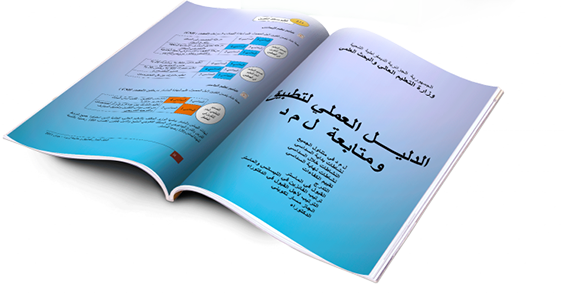The LMD system
The LMD system aims to achieve a number of objectives, including:
- Organizing the delivery of training by offering training in the form of courses that allow students to benefit from the support and advice of a reference teacher (supervisor).
- Improving educational quality by focusing on improving the quality of education, information, guidance, and support provided to students.
- Developing the professional nature of higher education by linking higher education to the needs of the labor market and developing students professional skills.
- Promoting the learning of interdisciplinary skills such as mastering foreign languages, computer tools, and the internet.
- Benefiting from the exchange and recognition of diplomas at the international level by making higher education certificates internationally valuable.
The three levels of the LMD system:
The LMD system is an educational system followed in many developed countries such as France and the United States of America. The LMD system is based on a special program called the Hexa program, which is currently being implemented in many Arab and European countries. The LMD system is based on three levels of training, each of which culminates in a university degree:
- First level: Baccalaureate + 3, culminating in a Bachelor’s degree after 180 credit hours at a rate of 30 credit hours per semester.
- Second level: Baccalaureate + 5, culminating in a Master’s degree after 120 credit hours at a rate of 30 credit hours per semester.
- Third level: Baccalaureate + 8, after three years culminating in a PhD degree.
1. Bachelor's degree
There are two types of bachelor’s degrees:
- Academic branch: This leads to an academic bachelor’s degree and allows the holder to continue their studies.
- Professional branch: This leads to a professional bachelor’s degree and allows the holder to enter the workforce directly.
Structure of the Bachelor’s Degree Training Paths:
- First phase: This phase lasts for a maximum of two semesters and is designed for students to get to know the university, adapt to it, and discover the different specializations.
- Second phase: This phase lasts for at least two semesters and is designed to deepen students’ knowledge and gradually guide them towards their chosen specialization.
- Third phase: This phase is designed for students to specialize in their chosen field and acquire the knowledge and skills necessary to succeed in that field.
2. Master's degree
This training lasts two years and is open to anyone with a “academic” bachelor’s degree who meets the admission requirements. Holders of a professional bachelor’s degree are also not excluded from participating. They can return to university after a short period of time in the working world. This training is available in two different specializations :
1. Professional Master’s Degree:
- It is characterized by obtaining broader training in a specific field.
- The orientation of this path is always professional.
2. Academic Master’s Degree:
- It is characterized by preparing the student for scientific research.
- It qualifies the student for research activity in the university or economic sector.
3. Phd Degree
The minimum training period is 6 semesters, and it includes deepening knowledge in the specialization. And training in research for research (developing the readiness to practice research and the meaning of social work…).
Regulatory texts
- Decree No. 711 of November 3, 2011, determining the common rules for the organization and pedagogical management of university studies for the degrees of Bachelor and Master
- Decree No. 712 of November 3, 2011, including the methods of evaluation, progression, and guidance in the two stages of studies for the degrees of Bachelor and Master
- Decree No. 713 of November 3, 2011, determining the composition and operation of the Supervision and Management Committee
- Decree No. 714 of November 3, 2011, including the methods of ranking students
- Decree No. 451 of December 9, 2012, determining the characteristics of the provisional success certificate in the two stages of training for the Bachelor's and Master's degrees
- Decree No. 452 of December 9, 2012, determining the characteristics of the transcript of records in the two stages of studies for the Bachelor's and Master's degrees
- Decree No. 453 of December 9, 2012, determining the characteristics of the descriptive document attached to the Bachelor's and Master's degrees
- Decree No. 992 of August 1, 2022, determining the methods of registration and re-registration for training to obtain the degrees of Bachelor, Master, State Engineer and Architect, as well as the methods of organization, evaluation and progression therein
- Decree No. 993 of August 2, 2022, determining the composition of the National Committee for Habilitation, its organization and operation
- Decree No. 994 of August 2, 2022, determining the data and characteristics of higher education diplomas
- Decree No. 998 of August 2, 2022, determining the conditions and methods of orientation and registration in university studies for the Master's degree
- Decree No. 059 of January 15, 2023, amending the appendix to Decree No. 1398 of October 22, 2022, which determines the educational program for the common core for the Master's degree in Engineering in the field of "Science and Technology"
- Decree No. 060 of January 15, 2023, amending the appendix to Decree No. 1399 of October 22, 2022, which determines the educational program for the common core for the Master's degree in Engineering in the field of "Mathematics and Computer Science", option "Computer Science"
- Decree No. 171 of February 9, 2023, determining the methods of registration and re-registration for training to obtain the degrees of Bachelor, Master, State Engineer and Architect, as well as the methods of organization, evaluation and progression therein
- Decree No. 396 of March 21, 2023, determining the conditions for admission and the methods of organizing and evaluating distance learning for obtaining the degrees of Bachelor, Master, State Engineer and Architect
- Decree No. 397 of March 21, 2023, amending and completing Decree No. 171 of February 9, 2023, which determines the methods of registration and re-registration for training to obtain the degrees of Bachelor, Master, State Engineer and Architect, as well as the methods of organization, evaluation and progression therein



